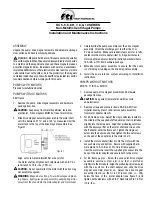
© Termo-tehnika, d.o.o.
17-16-27-3033-00
8
07/2016
3. In case of contact with the eyes: Immediately rinse with water and keep the eyelids
open during this time (at least 15 minutes).
4. Consult an eye doctor.
4.3.5 Fire prevention measures
1. Suitable fire extinguishing agents: The use of fore extinguishing agents is limited by the
room and circumstances in which the extinguishing takes place. The coolant does not
limit the use of any fire extinguishing agent
2. Special dangers:
Raising of pressure. In the presence of air (oxygen) at certain temperatures and
pressures, flammable substances can form.
At high temperatures (above 200°C), toxic and corrosive gasses can start
evaporating.
3. Special intervention methods: cool the part of the device or coolant subject to heat with
a fire extinguisher.
4. Protection for fire-fighters:
A fully closed mask with oxygen tube.
Full-body protection.
4.3.6 In case of leakage
1. Special safety precautions:
Avoid contact with skin and eyes - danger of frostbite.
Do not intervene without proper protective gear.
Do not inhale the fumes - danger of suffocation because of inadequate concentration
of oxygen in the air.
Evacuate the dangerous area.
Stop the leakage.
Remove all possible sources of ignition and heat.
Thoroughly vent the room where the coolant leakage occurred (danger of suffocation).
Avoid contact with skin and eyes
2. Cleaning / decontamination: Let the coolant evaporate.
4.3.7 Handling
1. Technical measures: Venting is necessary in case of leakage.
2. Safety precautions:
Smoking prohibited.
Prevent the build-up of electrostatic charge.
Maintenance and service works must be carried out only in a well vented room.
4.3.8 Personal protection
1. Respiratory system protection:
In case of insufficient venting: safety mask of AX type
In closed spaces: a fully closed mask with oxygen tube.
2. Hand protection: protective gloves made of nitrile rubber or leather.
3. Eye protection: protective glasses with side guards.
4. Skin protection: clothing mostly made of cotton.
5. Industrial hygiene: it is not allowed to drink, eat or smoke at the workplace.
4.3.9 Recycling
1. Product waste: Consult with the manufacturer in connection with recycling or
processing.
2. Dirty packaging: reuse or recycling after decontamination. Dispose of in designated
institutions.










































